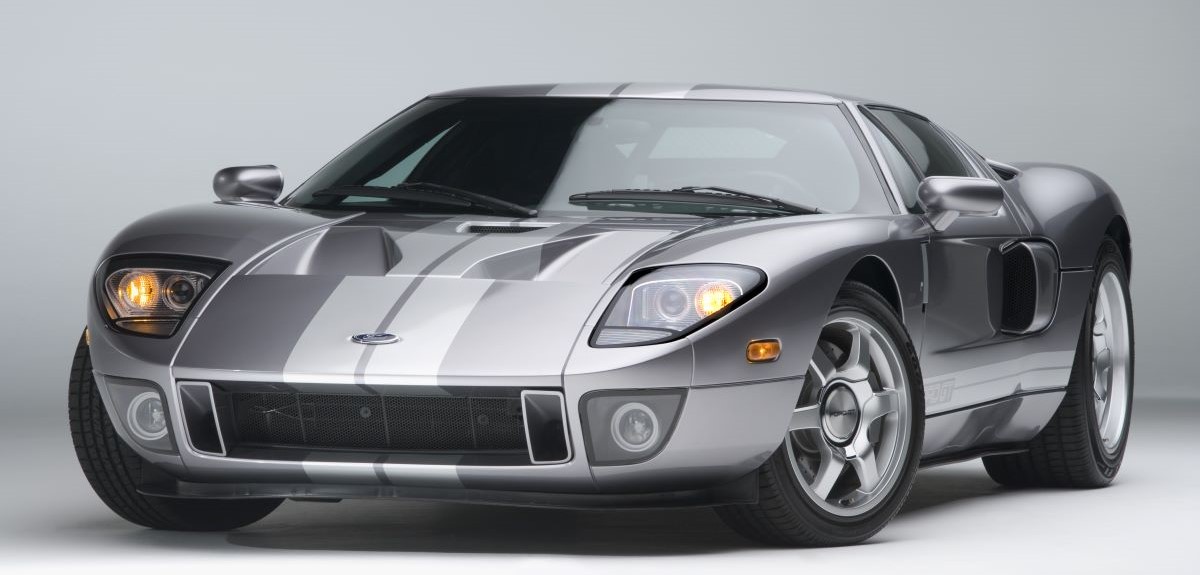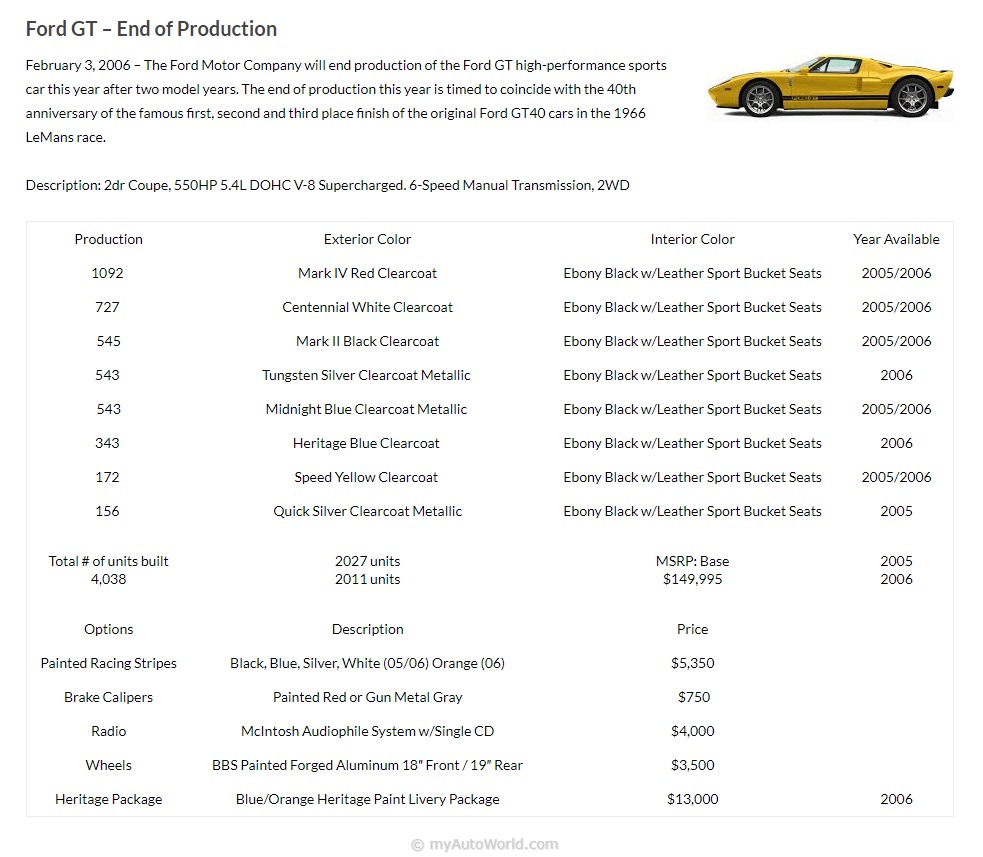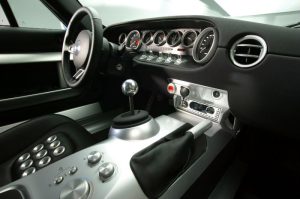
The original Ford GT was a pure race car built in the mid-1960s to take on Ferrari in the dem and ing 24-hour race at Le Mans. The Ford GT race car beat the world’s best in endurance racing, placing 1-2-3 at Le Mans in 1966.
2006 marks the 40th anniversary of that historic event, the start of Ford’s remarkable four-year winning streak of the world’s premier endurance race. A special limited-edition exterior color, Tungsten Grey, is being offered on the 2006 Ford GT to commemorate that sterling victory.
The original Ford GT racers were engineering and design marvels demonstrating Ford’s dedication and perseverance. In a few short years, under the direction of Henry Ford II, the company built a program from scratch that reached the pinnacle of international motorsports competition � and stayed there for four racing seasons.
Perhaps the world’s most significant � and glamorous � motorsport contest, Le Mans in the early 1960s was showing signs of becoming a Ferrari showcase, because the Italians had become the leaders in a number of endurance classes and events. But the Ford GT race car changed Le Mans forever, and today it signifies a new era for Ford Motor Company.
Design and Equipment
To commemorate the 40th Anniversary of the Ford’s first win at Le Mans , the 2006 Ford GT will be offered in a limited-edition Tungsten Grey, which replaces Quick Silver on the Ford GT’s color palette. A Quick Silver racing stripe can be added to the Tungsten Grey package.
Tungsten Grey was developed for the 2004 North American International Auto Show Ford “Performance Trilogy” show cars � the Ford GT, the Shelby Cobra roadster concept and the new 2005 Mustang GT. Customer dem and was so overwhelming that the color was added to the production palette.
“There’s good contrast between the colors,” says Camilo Pardo, chief designer of the Ford GT. “But it’s a discreet contrast. In Tungsten Grey, the Ford GT is really dressy, like a fine suit. It looks mature.”
Pardo notes that in the design studio, clay models are covered with “Dynoc” material that is a similar hue to Tungsten Grey. The color is specifically designed to enhance the vehicle design details for evaluation.
Unveiled at the 2002 North American International Auto Show, the GT40 concept became an instant sensation. And just 45 days after the vehicle was unveiled, Ford stunned the world again, officially announcing that a production version was in the works. Ford’s GT40 concept car was created to celebrate that great era in history and look forward to the great years to come.
Although the new production car and the original race car both share the mystique of the Ford GT name, they do not share a single dimension. The new car is more than 18 inches longer and st and s nearly 4 inches taller. Its new lines draw upon and refine the best features of Ford GT history and express the car’s identity through modern proportion and surface development.
The Ford GT production car, like the concept, casts the familiar, sleek look of its namesake; yet every dimension, every curve and every line on the car is a unique reinterpretation of the original. The car features a long front overhang reminiscent of 1960s-era race cars. But its sweeping cowl, subtle accent lines and high-intensity-discharge headlamps strike a distinctly contemporary pose.
The front fenders curve over 18-inch wheels and Goodyear Eagle F1 Supercar tires. In the tradition of original Ford GT racers, the doors cut into the roof. Prominent on the leading edge of the rear quarter panel are functional scoops that channel fresh air to the engine. The rear wheel wells, filled with 19-inch wheels and tires, define the rear of the car, while the accent line from the front cowl rejoins and finishes the car’s profile at the integrated “ducktail” spoiler.
The interior design incorporates the novel “ventilated seats” and instrument layout of the original car, with straightforward analog gauges and a large tachometer. Modern versions of the original car’s toggle switches operate key systems.
Looking in through the backlight, one finds the essence of the sports car in a 5.4-liter supercharged version of Ford’s MOD V-8 engine. The finishing touches are “Ford Blue” cam covers, each featuring an aluminum coil cover imprinted with the words “Powered by Ford.”
Powertrain and Chassis
The Ford GT team knew this road car would require a stiff structure, much like a race car. As such, they developed an all-aluminum space frame comprising extrusions, castings and several stampings. The hybrid aluminum space frame chassis is based on efficient use of 35 extrusions, seven complex castings, two semi-solid formed castings and various stamped aluminum panels.
The new Ford GT is intended for the road, unlike the original 1960s race cars that ultimately spawned a limited number of production road cars. However, the new car required unique race-like engineering solutions � like engineering out the aerodynamic “lift” inherent in the original car’s design � for a car that clocks in at more than 205 mph. The new Ford GT includes racing-inspired ground effects ducting under the rear fascia.
The Ford GT features many new and unique technologies, including super-plastic-formed aluminum body panels, roll-bonded floor panels, a friction-stir welded center tunnel, a capless fuel filler system, one-piece door panels and an aluminum engine cover with a one-piece carbon-fiber inner panel.
The chassis features unequal-length control arms and coil-over spring-damper units to allow for its low profile. Braking is h and led by four-piston aluminum Brembo monoblock calipers with cross-drilled and vented rotors at all four corners. When the rear canopy is opened, the rear suspension components and engine become the car’s focal point. Aluminum suspension components and 19-inch Goodyear tires � combined with the overwhelming presence of the V-8 engine � create a striking appearance and communicate the performance credentials of the Ford GT
The Ford GT engine, based on the largest V-8 in Ford’s modular engine family, produces 550 horsepower and 500 pound-feet of torque. Both figures are comparable to those of the 7.0-liter engine that won the 24 Hours of Le Mans in 1966 and 1967.
The 5.4-liter powerplant is all-aluminum and fed by an Eaton screw-type supercharger. It features four-valve cylinder heads and forged components, including the crankshaft, H-beam connecting rods and aluminum pistons. Power is put to the road through a Ricardo six-speed manual transaxle featuring a helical limited-slip differentia
Major Features and Options
Standard features include: Brembo mono block brake calipers, BBS™ cast-aluminum wheels with Goodyear Eagle F1 supercar tires, carbon-fiber bucket seats with ventilated leather seating surfaces, 6-speed manual transmission, AM/FM stereo with CD, bi-xenon headlamps, fog lamps, driver and passenger front air bags, ABS, leather-wrapped tilt steering wheel, passive anti-theft system, power exterior mirrors, windows and door locks, air conditioning, remote keyless entry and rear window defroster.
Options include BBS lightweight forged wheels, McIntosh™ sound system, painted brake calipers and racing stripes.


Specifications and Features
| TECHNICAL SPECIFICATIONS | |
| BODY | |
| Construction | Super plastic formed aluminum body panels, extruded-aluminum space frame |
| ENGINE | |
| Type | 5.4L 90-degree supercharged V-8; Aluminum block and heads |
| Manufacturing location | Romeo, Mich. |
| Configuration | V-8 |
| Intake manifold | Composite shell-welded Single-runner, charge motion control valves |
| Exhaust manifold | Cast iron |
| Crankshaft | Forged steel |
| Throttle body | 55-mm dual-bore electronic |
| Valvetrain | DOHC, 4 valves per cylinder,variable camshaft timing |
| Valve diameter | Intake: 33.8 mm Exhaust: 37.5 mm |
| Pistons | Forged aluminum |
| Connecting rods | H-beam aluminum |
| Ignition | Coil-on-plug, high-thread insert spark plugs |
| Bore x stroke | 3.55 x 4.17 in. / 90.2 x 105.8 mm |
| Displacement | 330 cu. in. / 5,409 cc |
| Compression ratio | 8.4:1 |
| Engine control system | Spanish Oak (Motorola MPC-565) |
| Horsepower | 550 @ 6,500 rpm |
| Horsepower per liter | 101.9 |
| Torque | 500 lb.-ft. @ 3,750 rpm |
| Redline | 6,500 rpm |
| Top speed | 205 mph |
| Recommended fuel | 91 octane premium |
| Fuel capacity | 17.5 gal. |
| Fuel economy | 13/21 |
| Fuel injection | Electronic returnless, sequential |
| Emission control | Closed loop with catalyst |
| Emissions (tailpipe/evaporation) | Tier 2, Bin 5 / LEV II Tier 2, Bin 5 / LEV II |
| Green States emissions (tailpipe/evaporation) |
LEV II LEV II |
| Oil capacity | 10.0 quarts |
| Recommended oil | 5W20 |
| Coolant capacity | 31.8 quarts |
| DRIVETRAIN | |
| Layout | Rear-wheel drive |
| TRANSMISSION | |
| Standard (Type) | Ricardo six-speed manual |
| Gear ratios | |
| 1st | 2.61:1 |
| 2nd | 1.71:1 |
| 3rd | 1.23:1 |
| 4th | 0.94:1 |
| 5th | 0.77:1 |
| 6th | 0.63:1 |
| Final drive | 3.36:1 |
| SUSPENSION | |
| Front | Unequal length upper A-armslower L-arm aluminum control arms, coil springs, monotube aluminum dampers, 23-mm tubular anti-roll bar |
| Rear | Unequal length upper A-armslower L-arm aluminum control arms, coil springs, monotube aluminum dampers, 19-mm tubular anti-roll bar |
| STEERING | |
| Type | Rack and pinion with power assist |
| Ratio | 17.0:1 |
| Turns lock-to-lock | 2.7 |
| Turning circle curb-to-curb | 40.0 ft. |
| BRAKES | |
| Type | Four-wheel disc, vacuum assist, ABS |
| Front | Cross-drilled and vented Brembo discs, four-piston monoblock 43-mm floating aluminum calipers |
| Swept area | 355.6 mm (14.0 in.) x 33 mm (1.3 in) |
| Rear | Cross-drilled and vented Brembo discs, four-piston monoblock 43-mm floating aluminum calipers |
| Swept area | 335.3 mm (13.2 in.) x 33 mm (1.3 in) |
| TIRES AND WHEELS (BRAND, TYPE, SIZE) | |
| Front | P235/45ZR-18 18 x 9 in. 6-spoke cast alloy wheels |
| Rear | P315/40ZR-19 19 x 11.5 in. 6-spoke cast alloy wheels |
| EXTERIOR | |
| Wheelbase | 106.7 in. |
| Overall length | 182.8 in. |
| Overall width | 76.9 in. |
| Overall height | 44.3 in. |
| Track width, front/rear | 63.0 in. / 63.7 in. |
| Ground clearance | 5.0 in. |
| INTERIOR | |
| Seating capacity | 2 |
| Front headroom | 35.4 in. |
| Front legroom | 44.6 in. |
| Front shoulder room | 57.8 in. |
| Front hip room | 57.7 in. |
| Passenger volume | 52.8 cu. ft. |
| Cargo volume | 1.6 cu. ft. |
| BASE CURB WEIGHT | |
| Manual transmission | 3,485 lbs. |
| Weight distribution (f/r) | 43/57 |
| SAFETY | |
| Safety belts | Height-adjustable lap and shoulder belts with load-limiting retractors and pyrotechnic pretensioners for front seating positions
Three-point safety belts for all seating positions BeltMinder™ safety-belt reminder chime for driver and front passenger |
| Air bags | Air bags � driver & front passenger (deactivation switch for passenger side) |
| Advanced restraints | Personal Safety System™, including dual-stage air bags with crash severity sensor, driver seat-position sensor and front passenger sensing system |
| Brakes | Anti-lock braking system |
| Fuel | Inertia-activated shutoff switch for fuel pump |
| Security | SecuriLock™ passive anti-theft system Remote keyless entry |
| Powerpoints | Single powerpoint located in instrument panel |
| Seats | Leather sport bucket seats with carbon fiber structure |
| EXTERIOR/INTERIOR COLORS | |
| Exterior colors | Speed Yellow Clearcoat, Mark IV Red Clearcoat, Midnight Blue Clearcoat Metallic, Tungsten Silver Clearcoat Metallic, Mark II Black Clearcoat, Centennial White Clearcoat |
| Interior color | Ebony Black Leather-Wrapped Interior |
| STANDARD EQUIPMENT | |
| Brembo® vented disc brakes w/4 piston calipers | |
| 6-speed Ricardo manual transaxle | |
| Aerodynamic Package | |
| Fog lamps | |
| Capless fuel filler in forged aluminum | |
| HID Headlamps | |
| Bodyside vinyl tape stripes | |
| Painted cast aluminum wheels; 18″ front, 19″ rear | |
| Manual air conditioning | |
| Cast magnesium floor console � w/polished aluminum shift knob w/6-speed pattern | |
| OPTIONAL EQUIPMENT | |
| BBS™ lightweight aluminum wheels | |
| Red or Gun Metal Gray painted brake calipers | |
| “FORD GT” body side tape stripe delete | |
| Painted Racing Stripes over hood, roof, rear hatch | |
| WARRANTY | |
| Warranty | 3-year / 36,000-mile bumper-to-bumper limited warranty 3-year / 36,000-mile powertrain 6-year / 100,000-mile corrosion |
| Milestones | |
| 1966 | Ford GT40s win 1-2-3 at Le Mans take the “triple crown” of endurance racing with victories at Sebring and Daytona as well |
| 1967 | Ford beats Ferrari by just four laps at Le Mans |
| 1968 | A GT40 in Gulf Oil orange and blue livery takes the checkered flag at Le Man |
| 1969 | GT40’s final Le Mans win with just two-second margin becomes one of the most exciting moments in the history of endurance racing |
| 2001/2002 | Living Legends studio in Dearborn begins work on GT40 concept / Bill Ford unveils GT40 concept at North American International Auto Show |
| 2003/2004 | Ford GT production starts to commemorate the Ford Motor Company centennial / Full-scale production begins |


